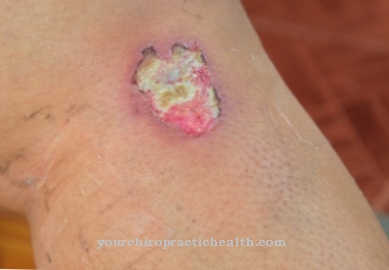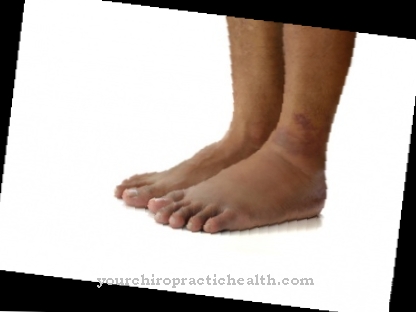Flatulence is air and other gases in the abdomen, which makes it painful, rumbling and sensitive to touch. Flatulence in babies especially in the first three months and can cause abdominal pain. This is also called the Three-month colic designated.
What are the characteristics of flatulence in babies?

Flatulence occurs in almost half of all infants. The baby feels very uncomfortable, which is why this situation can be very stressful. The same goes for parents as well. The air and gases get into the stomach through drinking, crying and breathing.
This is now tense, it feels hard, air is escaping and the baby draws its legs to get rid of the tormenting gases. The causes for this are very diverse. Some babies have to struggle very hard with the air in their tummy and plop down after each meal, while other babies have no problems at all.
causes
The reasons for the complaints could not yet be precisely clarified. The baby's metabolism is particularly characterized by its rapid growth. Birth weight roughly doubles in the first six months, while it triples in the first year of life. In addition, there are the partially immature functions of the organs. Some enzymes are not yet fully functional. Therefore occasional flatulence is normal because the intestinal flora is still developing.
However, real colic in babies can have a variety of causes. The colic phase usually ends in the baby's fourth month of life. Various gases are formed in the gastrointestinal tract through various processes. The intolerance of lactose and gluten also contribute to gas formation. Psychosomatic factors can also play a role, for example stress, restlessness and tension in the parents.
If this is the trigger for the flatulence, it is indicated by the fact that the crying of the infant, which results from the abdominal pain, leads to conflict in the relationship between the parent and the child. On the other hand, it also becomes clear that problems between parents lead to greater restlessness in the baby. Babies who cry a lot will choke more air, which can lead to colic.
Diseases with this symptom
- Milk protein allergy
- Celiac disease
- Intestinal obstruction
- Intestinal colic
- Food intolerance
- abdominal influenza
- Three-month colic
- Lactose intolerance
- Food poisoning
Diagnosis & course of disease
Most of the time, the flatulence is normal and harmless. However, if the hyperinflation is very severe and no explanation can be found, the cause should be investigated. The same applies if there are additional complaints, for example abdominal pain or irregular stool. In this case a doctor should be consulted.
The personal habits and current complaints are researched. All cards have to be on the table, even if it is sometimes embarrassing. This is followed by a physical examination and any further diagnostic measures. First of all, the general state of health is checked. The baby's belly is looked at, palpated, tapped and listened to with the stethoscope. The anal canal may also be examined.
If a certain diagnosis is suspected, further examinations often follow to confirm it, for example metabolism or breath tests to detect a food intolerance. A food diary can also be helpful in this regard to determine which foods could be associated with the symptoms. Other options are laboratory analyzes of the stool and blood or an endoscopy to enable insight into the organs.
Complications
Flatulence in the baby is harmless in most cases, even if it is uncomfortable for the baby. It can get complicated with infants who are already difficult to breastfeed or feed, because when they feel bad they drink less or, in the worst case, they drink no more. However, small babies in particular regularly need new food and quickly become even more sick if they do not want to eat it.
Fortunately, parents quickly develop their own methods of whetting the baby's appetite anyway - and that way they may not even realize if the baby is gasping a little too often. Particular caution is required in the first three months of life, because now the abdominal pain known as three-month colic can occur. Even if they usually do not need treatment, the pediatrician should still have looked at them. Frequent flatulence in babies is therefore a reason for a doctor's examination.
There is also the risk that intolerance to certain foods and constituents of the baby porridge, which lead to gas in the baby, are overlooked because the parents already know them and assume that everything is fine. When the baby is given the first porridge food, in order to detect intolerances, it should be documented all the more precisely how the baby reacts to each new ingredient.
When should you go to the doctor?
Flatulence in babies is typical for the first 3 to 5 months. Parents recognize this by the fact that their child then tightens their legs, whines or cries and generally appears restless. Bloating in babies is often associated with pain. The stomach feels tense and hard. Flatulence affects between 25% and 50% of infants. These are often referred to as three-month colic.
The cause of flatulence in babies is not yet fully understood. It is assumed that the intestinal flora which is still developing is causing the symptoms. In addition, infants do not yet have all digestive enzymes, so that their intestines are initially overwhelmed with various food components, which leads to flatulence.
If parents think that their baby is suffering from flatulence or are concerned that an illness is behind it, it is best to take their baby to a pediatrician. If there is an illness, it will be treated immediately. If everything is okay, the parents are reassured. The pediatrician also has advice on how to reduce flatulence in babies, for example through optimal breastfeeding technique, fennel tea, caraway suppositories or specific movement of the legs by the parents.
Doctors & therapists in your area
Treatment & Therapy
A good help against flatulence in babies is physical closeness through the parents. The so-called pilot's grip therefore works very well. For this, the stomach is placed on the stomach on the forearm and the free hand is placed under the stomach. The light pressure and the warmth often relieve the baby from stomach ache. Other good ways to relieve the flatulence are an abdominal massage and warmth, for example with a hot water bottle or a cherry stone pillow.
The pillow is placed on the child's stomach, which is then massaged with light pressure and in circular movements. Light gymnastic exercises are also helpful. For this, the baby is placed on its back on the changing mat without a diaper. The bent legs are pressed lightly against the stomach. The baby should remain in this position for about half a minute. Then the legs are slowly stretched again. This exercise can be repeated several times.
Tension in the stomach can be released and the air can escape. Herbal teas given between meals, but not replacing them, help calm the digestive organs. Fennel, anise and caraway have an antispasmodic effect. In the case of very severe flatulence, Simeticon and Dimeticon (active ingredients) are sometimes administered. The pediatrician can advise on this.
Outlook & forecast
Flatulence in babies is a normal part of the development of their metabolism. That is why they occur especially in the first few months of life of the little earthly citizen, as long as the metabolism has not yet got used to liquid and solid food. They are unproblematic and will improve on their own, even if they occasionally cause the baby to cry.
However, especially in the first few weeks of life, parents should pay attention to whether gas is frequent and associated with pain, which the baby will express by frequent crying. This in turn can be an indication that there is an intolerance to the food.
This does not usually occur with breast milk, but it can occur with bottle feeding. In these cases, the baby will need a different type of formula. When the baby is given solid food for the first time and reacts with gas, it helps to stop offering the food that triggered it. The metabolism is probably not ready yet - if it is offered again a few weeks or months later, the baby can tolerate it much better.
In addition, it is advisable to only feed babies one type of vegetable or fruit at a time when starting out. Firstly, it helps the metabolism to get used to the new food, and secondly, it makes it easier to determine what a baby is reacting to with flatulence, so that such food is no longer offered at first.
Prevent
When feeding the baby with the bottle, it is important that there is no foam left in it from shaking. Light, circular massages applied regularly in a clockwise direction relax the stomach. Additional caraway oil intensifies the effect. The so-called pork after feeding shows that the flatulence has disappeared.
There should be a sufficient interval between breastfeeding meals, because if new milk is constantly added, this can lead to digestive problems. In addition, it is important that the baby's mouth encloses the nipple or the nipple of the bottle well so that as little air as possible gets into the stomach. Fennel tea or massages with caraway seed oil can prevent flatulence.
You can do that yourself
Babies often suffer from gas and are difficult to calm down. Proven home remedies provide a remedy here. The pilot's grip is particularly suitable for babies with flatulence. They enjoy being carried around, preferably in a sling. With the aviator grip, the baby is placed face down on the forearm. The free hand is under his stomach. The resulting warmth and the slight pressure relieve the stomach pain.
In addition, warmth reduces the abdominal pain caused by flatulence. It makes sense to bathe the baby and then put on thick stockings. A warmed cherry stone or spelled grain pillow also provides relief. However, this must not be too hot! Alternatively, a hot water bottle is recommended. However, the hot water bottle must be covered with a cloth. The baby is then placed on its stomach on top. Parents should make sure that the cap is properly closed and that the temperature is not too high.
Flatulence in babies can also be reduced with light massages. Parents massage their baby's tummy with a little oil or an ointment. In order for the gases to escape, the abdomen must be gently massaged clockwise in a circular manner.Midwives recommend helpful techniques. Afterwards, warm compresses can provide a pleasant feeling and reduce gas.

























.jpg)

.jpg)
